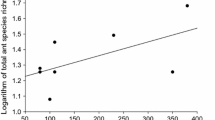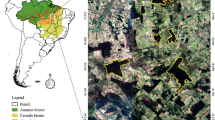Abstract
Studies about processes determining biodiversity in Pantanal are urgently needed and the use of invertebrates for this purpose may be an efficient tool. The purpose of this paper is to verify whether ants could be used to predict human impacts on Pantanal, assessing how environmental characteristics of gallery forest influence arboreal ant species richness. Specifically, we tested the hypotheses that: (i) resource availability (estimated by tree density) and (ii) diversity of environmental conditions (estimated by structural heterogeneity) positively influence arboreal ant species richness and composition. Ants were sampled in a gallery forest in the Miranda River. Ant species richness did not respond to tree density, but increased with structural heterogeneity. Species composition was affected both by tree density and structural heterogeneity. The species list produced in the present study showed a high similarity between arboreal ant faunas of Cerrado and Pantanal, which are contiguous biomes. The relationship of ant species richness with heterogeneity, as well as the observed changes of species composition with tree density and heterogeneity may be explained by the presence of a variation of environmental conditions, which create several micro-habitats in the forest. The response of the ant community can reflect human impacts on the forests of the studied region, which are usually modified to create patches for sport fishing and by pathways used in ecotourism.
Similar content being viewed by others
References
Acosta FJ, López F, Serrano JM (1995) Dispersed versus central-place foraging: intra and intercolonial competition in the strategy of trunk trail arrangement of a harvester ant. The Am Nat 145:389–411
Adis J, Junk WJ (2002) Terrestrial invertebrates inhabiting lowland river floodplains of Central Amazonia and Central Europe: a review. Freshwater Biol 47:711–731
Andersen AN, Patel AD (1994) Meat ants as dominant members of Australian ant communities: an experimental test of their influence on the foraging success and forager abundance of other species. Oecologia 98:15–24
Andersen AN, Hoffman BD, Müller WJ, Griffiths AD (2002) Using ants as bioindicators in land management: simplifying assessment of ant community responses. J Appl Ecol 39:8–17
Armbrecht I, Rivera L, Perfecto I (2005) Reducer diversity and complexity in the leaf-litter ant assemblages of Colombian coffee plantations. Conserv Biol 19:897–907
Bell G, Lechowicz MJ, Appenzeller A, Chandler M, Deblois E, Jackson L, Mackenzie B, Preziosi R, Schallenberg M, Tinker N (1993) The spatial structure of the physical environment. Oecologia 96:114–121
Bell G, Lechowicz MJ, Waterway MJ (2000) Environmental heterogeneity and species diversity of forest sedges. J Ecol 88:67–87
Berto Júnior V (1999) Interações entre formigas e Inga vera Willd ssp. affinis (D.C.) Pennington (Mimosoideae: Leguminosae): ausência de benefício em uma planta com nectários extraflorais no Pantanal Sul-mato-grossense. M.S. thesis, FUFMS, Mato Grosso do Sul, Brazil
Bestelmeyer BT, Wiens JA (2001) Ant biodiversity in semiarid landscape mosaics: the consequences of grazing vs. natural heterogeneity. Ecol Appl 11:1123–1140
Blüthgen N, Verhaagh M, Goitia W, Jaffé K, Morawetz W, Barthlott W (2000) How plants shape the ant community in the Amazonian rainforest canopy: the key role of extra floral nectaries and homopteran honeydew. Oecologia 125:229–240
Bolton B (1994) Identification Guide to the Ant Genera of the World. Harvard University Press, Cambridge
Bragança M, DeSouza O, Zanuncio JC (1998) Environmental heterogeneity as a strategy for pest management in Eucalyptus plantations. Forest Ecol Manage 102:9–12
Calheiros DF, Seidl AF, Ferreira CJA (2000) Participatory research methods in environmental science: local and scientific knowledge of a limnological phenomenon in the Pantanal wetland of Brazil. J Appl Ecol 37:684–696
Cerdá X, Retana J, Cros S (1997) Thermal disruption of transitive hierarchies in Mediterranean ant communities. J Anim Ecol 66:363–374
Cooper SD, Barmuta L, Sarnelle O, Kratz K, Diehl S (1997) Quantifying spatial heterogeneity in streams. J North Am Benthol Soc 16:174–188
Corrêa MM (2002) Diversidade de formigas em capões no Pantanal da Nhecolândia: um teste da hipótese de biogeografia de ilhas. M.S. thesis. UFMS, Mato Grosso do Sul, Brazil
Cramer MJ, Willig MR (2005) Habitat heterogeneity, species diversity and null models. Oikos 108:209–218
Crawley MJ (2002) Statistical computing – An introduction to data analysis using S-plus. John Wiley and Sons, England
da Silva MP, Mauro R, Mourão G, Coutinho M (2000) Distribuição e quantificação de classes de vegetação do Pantanal através de levantamento aéreo. Rev Bras Bot 23:143–152
Deslippe RJ, Savolainen R (1995) Mechanisms of competition in a guild of formicine ants. Oikos 72:67–73
Dostal P, Breznova M, Kozlickova V, Herben T, Kovar P (2005) Ant-induced soil modification and its effect on plant below-ground biomass. Pedobiologia 49:127–137
Fonseca CR (1999) Amazonian ant-plant interactions and the nesting space limitation hypothesis. J␣Trop Ecol 15:807–825
Fonseca CR, Ganade G (1996) Asymmetries, compartments and null interactions in an Amazonian ant-plant community. J Anim Ecol 65:339–347
Furley PA (1999) The nature and diversity of neotropical savanna vegetation with particular reference to the Brazilian cerrados. Global Ecol Biogeogr 8:223–241
Giladi I (2006) Choosing benefits or partners: a review of the evidence for the evolution of myrmecochory. Oikos 112:481–492
Gomez JM (2000) Effectiveness of ants as pollinators of Lobularia maritima: effects on main sequential fitness components of the host plant. Oecologia 122:90–97
Hamilton SK (2002) Human impacts on hydrology in the Pantanal wetland of South America. Water Sci Technol 45:35–44
Harris MB, Tomas W, Mourão G, Silva CJ, Guimarães E, Sonoda F, Fachim E (2005) Safeguarding the Pantanal wetlands: threats and conservation initiatives. Conserv Biol 19:714–720
Hawkins BA, Pausas JG (2004) Does plant richness influence animal richness? The mammals of Catalonia (NE Spain). Divers Distrib 10:247–252
Kerr JT, Packer L (1997) Habitat heterogeneity as a determinant of mammal species richness in high-energy regions. Nature 385:252–254
Kerr JT, Southwood TRE, Cihlar J (2001) Remotely sensed habitat diversity predicts butterfly species richness and community similarity in Canada. Proc Natl Acad Sci USA 98:11365–11370
Krebs CJ (1989) Ecological methodology. Harper and Row, New York
Lewinsohn TM, Freitas AVL, Prado PI (2005) Conservation of terrestrial invertebrates and their habitats in Brazil. Conserv Biol 19:640–645
Li H, Reynolds JF (1995) On definition and quantification of heterogeneity. Oikos 73:280–284
Lundholm JT, Larson DW (2003) Relationships between spatial environmental heterogeneity and plant species diversity on a limestone pavement. Ecography 26:715–722
Nestel D, Dickschen F (1990) The foraging kinetics of ground ant communities in different Mexican coffee agroecosystems. Oecologia 84:58–63
Oliveira PS, Pie MR (1998) Interaction between ants and plants bearing extrafloral nectaries in cerrado vegetation. Anais da Sociedade Entomológica do Brasil 27:161–176
Oliveira PS, Oliveira-Filho AT, Cintra R (1987) Ant foraging on ant-inhabited Triplaris (Polygonaceae) in western Brazil: a field experiment using live termite-baits. J Trop Ecol 3:193–200
Orr MR, Dahlsten DL, Benson WW (2003) Ecological interactions among ants in the genus Linepithema, their phorid parasitoids, and ants competitors. Ecol Entomol 28:203–210
Perfecto I, Vandermeer J (1996) Microclimatic changes and the indirect loss of ant diversity in a tropical agroecosystem. Oecologia 108:577–582
R Development Core Team (2005) R: A language and environment for statistical computing. R Foundation for Statistical Computing, Vienna, Austria. ISBN 3-900051-00-(3) URL http://www.R-project.org
Rezende AV (1998) Importância das matas de galeria: manutenção e recuperação. In: Ribeiro JF (ed) Cerrado: matas de galeria. EMBRAPA-CPAC, DF Brazil, pp 3–16
Ribas CR, Schoereder JH (2002) Are all ant mosaics caused by competition? Oecologia 131:606–611
Ribas CR, Schoereder JH, Pic M, Soares SM (2003) Tree heterogeneity, resource availability, and larger scale processes regulating ant species richness. Austral Ecol 28:305–314
Ribeiro JF, Walter BMT (1998) Fitofisionomias do bioma cerrado. In: Sano SM, Almeida SP (eds) Cerrado: ambiente e flora. EMBRAPA-CPAC, DF Brazil, pp 89–166
Rojas P, Fragoso C (2000) Composition, diversity, and distribution of a Chihuahuan desert ant community (Mapimí, México). J Arid Environ 44:213–227
Roth RR (1976) Spatial heterogeneity and birds species diversity. Ecology 57:773–782
Savolainen R, Vepsäläinen K (1988) A competition hierarchy among boreal ants: impact on resource partitioning and community structure. Oikos 51:135–155
Seidl AF, Silva JSV, Moraes AS (2001) Cattle ranching and deforestation in the Brazilian Pantanal. Ecological Economics 36:413–425
Soares SM, Schoereder JH (2001) Ant-nest distribution in a remnant of tropical rainforest in Southeastern Brazil. Insect Soc 48:280–286
Soares SM, Schoereder JH, DeSouza O (2001) Processes involved in species saturation of ground-dwelling ant communities (Hymenoptera, Formicidae). Aust Ecol 26:187–192
Sobrinho TG, Schoereder JH, Sperber CF, Madureira MS (2003) Does fragmentation alter species composition in ant communities (Hymenoptera: Formicidae)? Sociobiology 42:329–342
Tews J, Brose U, Grimm V, Tielbörger K, Wichmann MC, Schwager M, Jeltsch F (2004) Animal species diversity driven by habitat heterogeneity/diversity: the importance of keystone structures. J Biogeogr 31:79–92
Tilman D, Pacala S (1993) The maintenance of species richness in plant communities. In: Ricklefs RE, Schluter D (eds) Species diversity in ecological communities. The University of Chicago Press, Chicago, pp 13–25
Uehara-Prado M (2005) Effects of land use on ant species composition and diaspore removal in exotic grasslands in the Brazilian Pantanal (Hymenoptera: Formicidae). Sociobiology 45:915–923
Yu DW, Davidson DW (1997) Experimental studies of species-specificity in Cecropia–ant relationships. Ecol Monogr 67:273–294
Zerm M, Adis J (2001) Spatio-temporal distribution of larval and adult tiger beetles (Coleoptera: Cicindelidae) from open areas in Central Amazonian floodplains (Brazil). Stud Neotrop Fauna Environ 36:185–198
Acknowledgements
We gratefully acknowledge W. D. Fernandes by the opportunity of participation in the course Field Entomology of the Graduate Program Entomology and Biodiversity Conservation (Universidade Federal de Mato Grosso do Sul, Dourados) and by discussions Thanks to Seu Geraldo, the students and teachers of the course, especially to J. C. Nascimento, J. C. Gaona, A. K. Brizola and M. C. N. F. Bendasoli for the help in field sampling. J. Raizer helped in initial thoughts. C. Galbiati, C. F. Sperber, F. S. Neves, L. Sousa-Souto, M. S. Madureira, R. B. F. Campos, T. G. Sobrinho, W. D. Fernandes and two anonymous referees read previous drafts and gave important suggestions. C. R. Ribas is supported by a CAPES grant. J. H. Schoereder is supported by a CNPq grant. FAPEMIG supported this study.
Author information
Authors and Affiliations
Corresponding author
Rights and permissions
About this article
Cite this article
Ribas, C.R., Schoereder, J.H. Ant communities, environmental characteristics and their implications for conservation in the Brazilian Pantanal. Biodivers Conserv 16, 1511–1520 (2007). https://doi.org/10.1007/s10531-006-9041-x
Received:
Accepted:
Published:
Issue Date:
DOI: https://doi.org/10.1007/s10531-006-9041-x




